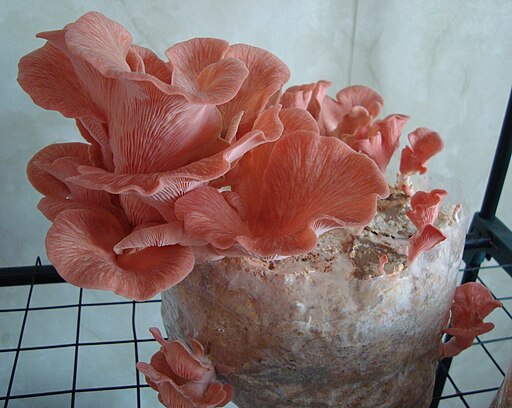What is Solid State Fermentation (SSF)?
In Solid State Fermentation, also called Solid Substrate Fermentation or SSF, the fermentation substrate or media will be in the solid state. Here the microorganisms are grown on a solid substratum in the absence or near absence of free water. The moisture content of the substratum in SSF is usually maintained below 15%.
The solid state fermentation is most commonly carried out for the production of fermented food products such as bread, fermented fish, meat, yogurt, cheese and pickles. The microbial fermentation increases the nutrient content and flavor of food products. It also increases the digestibility of foods. The cultivation of edible mushrooms on a suitable substratum is also a solid state fermentation process.
Substrates / Media in Solid State Fermentation
The substrates commonly used in SSF are usually very complex, heterogeneous and are insoluble in water. These substrates include cereals grains, wheat bran, lingo-cellulosic materials such as wood shavings, sawdust, molasses etc. In most of the cases, the substrate or the raw materials were undergone through a pre-treatment such as soaking, boiling in water, mechanical pre-treatment or chemical treatment. These pre-treatments increase the bioavailability of nutrients for the microbes to act on them.
| You may also like NOTES in... | ||
|---|---|---|
| BOTANY | BIOCHEMISTRY | MOL. BIOLOGY |
| ZOOLOGY | MICROBIOLOGY | BIOSTATISTICS |
| ECOLOGY | IMMUNOLOGY | BIOTECHNOLOGY |
| GENETICS | EMBRYOLOGY | PHYSIOLOGY |
| EVOLUTION | BIOPHYSICS | BIOINFORMATICS |
Instrumentation and Growth Kinetics in Solid State Fermentation
The solid state fermentation usually lacks the sophisticated instrumentation and control systems that are usually associated with submerged fermentation process. The controls of growth kinetics of the microbes are also very limited in solid state fermentation since it is very difficult to maintain the accurate moisture and temperature in the medium.
Water Activity (Aw) in Solid State Fermentation
The moisture content in SSF is very less, usually maintained below 15%. Water is lost during the fermentation process by the metabolic activities of the microbes and also by evaporation. It is essential to keep to optimum moisture condition in the substratum. If the moisture is too low, the microbes cannot access the substrate and the growth rate of them will be reduced. In the same time, if the water content is too high in the medium, the microbial growth will be hindered. This is because, at higher water concentration, the gaseous exchange in the medium is drastically reduced. High water content will also cause microbial contamination in the medium.
Microbes in Solid State Fermentation
Solid state fermentation usually does not require strict sterilization and ascetic conditions. The SSF is usually carried out as a non-aseptic process. Hence the sterilization costs are very less in SSF. Ample air circulation between the substrates should be ensured for the successful fermentation process in SSF. In SSF, excessive heat will be generated in the substrate and it should be cooled by providing adequate air circulation. The cultures used in SSF may be pure cultures or mixed cultures depending upon the requirement.
Examples of Solid State Fermentation
@. Cultivation of mushrooms such as Agaricus, Pleurotus on sawdust or hay.
@. Production of cheese by the fermentation of milk by Penicillium roqueforti.
@. Production of Sauerkraut by the fermentation of cabbage by lactic acid bacteria.
@. Production of organic acids from molasses by Aspergillus niger.
@. Production of enzymes such as α-amylase by Aspergillus niger.
Bioreactors in Solid State Fermentation
The SSF process is relatively simple and so as the bioreactors used for the fermentation. Most of the solid state fermentation systems are Fed Batch Fermentation Systems. The commonly used fermenter types in SSF are given below:
(1). Rotating Drum Fermenter: A large cylindrical vessel with rotation facility. Commonly used for the production of enzymes and biomass.
(2). Tray Fermenters: They are extensively used for the production of fermented food products. The substratum is spread over the tray (2 cm thick) and allows to ferment for the required period of time. If many trays are present, they are mounted one above the other.
(3). Bed System: Typically used for the production of Koji. It consisting of a bed of substrate up to 1m deep, through which humidified air is continuously passed.
(4). Column Bioreactors: They are commonly used for the production of organic acids and ethanol. Consists of large plastic or glass columns in which the substrate is loosely packed.
(5). Fluidized Bed Bioreactors: It is used for the production of animal feeds. Fluidized bed fermenters use continuous agitation and air flow through the medium.
Advantages of Solid State Fermentation
Ø SSF requires only simple nutrient media as the substrate.
Ø Requires very less technology or instrumentation.
Ø Capital investment required is very low.
Ø Energy expenditure will be low.
Ø Sterilization of the media is not required.
Ø Chance of microbial contamination is very less.
Ø Downstream processing (purification of products) is very easy.
Ø The yield is usually very high.
Ø The design of bioreactor is very simple.
Ø A variety of natural substrates can be used.
Ø Domestic, agricultural and industrial wastes can be efficiently used as substrate in SSF and useful products can be generated from them.
Ø Low waste water generation
Ø No problem with foaming
Ø Sporulation of some fungi can only be attained by SSF since these fungi do not sporulate in liquid medium (Example: Coniothyrium minitans – a biocontrol agent).
Ø Resembles the natural habitat of microbes.
Disadvantages of Solid State Fermentation
Ø Only those microbes that can survive in low moisture condition can be used in SSF.
Ø Precise monitoring and accurate regulation of the fermentation process is not possible with SSF.
Ø The growth rate of microbes on solid substratum is relatively slow.
Ø Scale-up of the fermentation process is difficult.
Ø Fermentation usually produces excessive heat in the medium.
Ø The environmental conditions of the microbes cannot be regulated in SSF.
Ø Bacterial contamination sometimes problematic.
<<< Back to Biotechnology Notes

